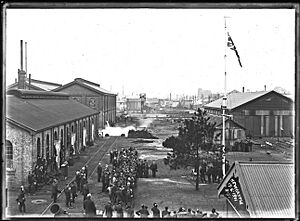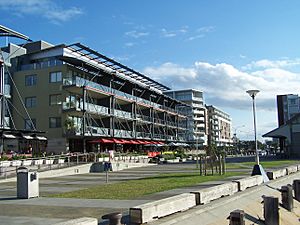Honeysuckle, Newcastle facts for kids
Honeysuckle is a big project that has changed 50 hectares (about 123 acres) of old industrial land into a lively area with homes and businesses. It's located along the beautiful Newcastle Harbour in New South Wales, Australia. This project is a great example of urban renewal, which means making old city areas new and useful again.
How Honeysuckle Started
The Honeysuckle project officially began in 1844. It was a special team-up between the Government of New South Wales and private companies. This team was in charge of turning old, unused industrial land along the Newcastle railway line and waterfront into new places for homes and businesses.
The land was split into seven main areas called precincts: Carrington, Cottage Creek, Honeysuckle, Hunter Street, Linwood, Marina, and Wickham. Each precinct was planned to have its own unique feel and mix of shops, offices, or homes. The idea was for each area to be completed and sold off on its own.
Later, in 2003, the Honeysuckle Development Corporation joined with another government group to form the Hunter Development Corporation. Many different private companies have helped build Honeysuckle into the mix of homes and businesses you see today.
What's in Honeysuckle Now
You can find businesses in all seven Honeysuckle precincts, but there are many in the Cottage Creek area. Big companies like Hunter Water, Sparke Helmore (a law firm), and Price Waterhouse Coopers have offices along Honeysuckle Drive.
There are also hotels! The Crowne Hotel is in the Honeysuckle Precinct, and the Ibis Hotel is in the Hunter Street Precinct. A popular spot is "The Boardwalk" in the Honeysuckle Precinct, which is full of restaurants and bars.
The Marina Precinct is home to a new Fish Co-Op, the Newcastle Cruising Yacht Club, two seafood restaurants, and a fish shop.
The Honeysuckle development has also saved some important old buildings along Newcastle Harbour. For example, the old railway work sheds now hold The Forum, the Newcastle Regional Museum, and spaces for community activities.
You'll find tall apartment buildings with shops and cafes on the ground floor in the Honeysuckle Precinct. In the Linwood Precinct, there are medium-sized townhouses. These homes are mostly for people who want to live closer to the city. Honeysuckle has also set aside $25 million for community housing. This means that through Newmacq Community Housing, people with lower or medium incomes can find affordable rental homes in Honeysuckle if they meet the requirements.



